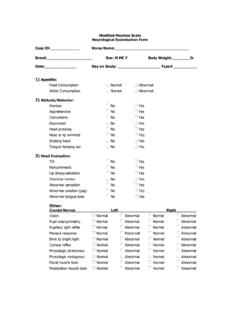Transcription of PEPTIDE-ELISA New peptide-based serological …
1 PEPTIDE-ELISA New peptide- based serological testing can determine the presence of equine protozoal myelitis infections by detecting seroconversion after infection. The serological identification of strain specific peptides can distinguish all known virulent genotypes by their phenotype, SAG 1, 5, or 6. The selection of allele specific proteins ensures that there are no cross-reactions with co-incident, non-pathogenic organisms. Thus there are no false positive results. Common antigens are eliminated by selecting specific protein markers (virulence factors).
2 The rapid ELISA format yields a test result to each phenotype. We chose well characterized cases of EPM to develop allele specific proteins that identify strain types that are suggested to play a role in the outcome of Sarcocystis neurona infections in horses. Various strains produce severe or mild disease that can depend on the parasite load particular to the strain of parasite. Some phenotypes do not enter the CNS and are not neurovirulent. based on biological and molecular assays it was demonstrated that 47% of opossums carry mixed populations of Sarcocystis, 22% carry the non-pathogen S.
3 Falcatula, 31% carry Sarcocystis common to the raccoon, and 8% carry virulent Sarcocystis neurona. The presence of a virulent phenotype increases the risk factors and prevalence of disease in horses. While exposure to Sarcocystis is regional (35% in California, 80% in Oklahoma, 65% in Texas, 66% in Kentucky, 56% in Florida, and 57% in New York)1 and retrospective sero-surveillance predicts high false positive results on non-specific tests, the PEPTIDE ELISA determines actual exposure by eliminating false positive test results and reveals the phenotype of the infection.
4 As we determine the phenotype responsible for infections in horses we predict that the incidence of EPM in exposed horses will be: in California, in Oklahoma, in Texas, in Kentucky, in Florida, and in New York. In previously reported work we have shown that seroprevalence to SnSAG1 in EPM suspect horses is 6%. Our continuing work will determine the seroprevalence of SnSAG5 and 6 in the equine population. Now available at Pathogenes, Inc. and available soon at other leading laboratories. 1 ACVIM EPM special session 2005







